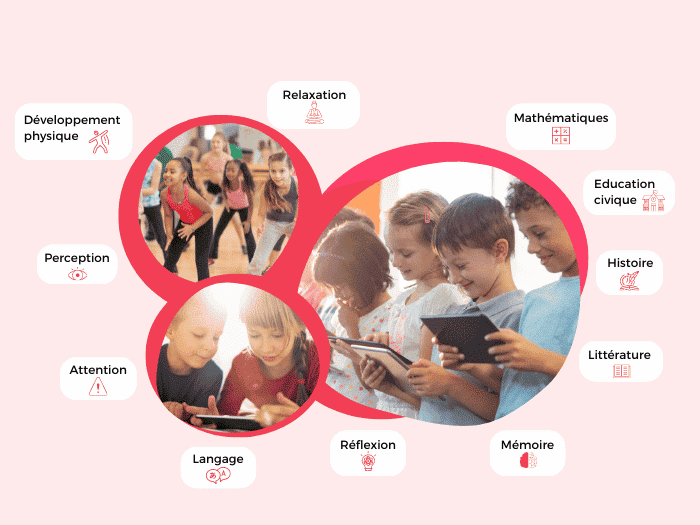We are always more worried when our children are not by our side. The concern can become even greater when we have enrolled a child with a disability in school.
An AESH (Accompanying Students with Disabilities) or AVS (School Life Assistant) provides tailored support. What role does this professional play? Here’s a brief reminder of what you need to know about this profession.
What is an AVS, an AESH?
Whether “AVS” or “AESH”, these two acronyms are used to refer essentially to the same profession. Here is a brief overview.
Overview of an AVS or an AESH
As mentioned earlier, AVS stands for school life assistant. This professional works in a school setting. Today, we mainly talk about AESH (Accompanying Students with Disabilities). This person works at the elementary level as well as in middle and high schools. An AVS will thus intervene within a regular class or a specialized class. They mainly assist students with disabilities. Indeed, the integration of these students is not easy. Therefore, a professional is needed to help them integrate better.
A life assistant can support disabled students in two ways. Thus, they can provide individual support or collective support. Whether one or the other, the disabled person benefits from support tailored to their daily educational needs. For example, a school life assistant can also intervene in a ULIS class (Localized Unit for School Inclusion).
They are qualified!
A student with a disability needs adapted educational support. The AESH aims to be an important player in their daily life. Access to this role is very well regulated. The accompanying person for students with disabilities is a professional who has obtained a “State Diploma for Educational and Social Accompaniment,” abbreviated as “DEAES.” The training lasts from 1 to 2 years.
However, not all current AESH or AVS have a DEAES. Another pathway to this role is obtaining a professional diploma, but rather in the field of personal assistance. Regarding the DEAES, it should be noted that it is a level V diploma. It is also worth mentioning that this training offers a choice between 3 specializations.
What are the specificities of the AESH / AVS profession?
This is indeed a profession that we do not really know. Unfortunately, many families do not know that professional support at school is possible until they hear about it from another parent or from teachers.
Here is a brief overview of the role and missions assigned to an AESH or AVS.
A role of educational support
The qualified professional provides educational assistance to students with disabilities or learning difficulties. The support concerns the student’s life in class. Thus, an AESH intervenes to help your child gain autonomy. For the objectives to be truly achieved, know that this professional works in perfect collaboration with the teacher. They respect the content of the educational courses proposed by the latter.
The AESH or AVS helps the disabled child better assimilate the lessons and adhere to instructions. However, their action does not aim to replace the disabled student or do their homework for them.
Varied missions
They intervene in the daily learning of the student with a disability. These learnings can be of various kinds: one student may face a note-taking issue, while another may need support with handling school materials… The accompanying person for students with disabilities is able to provide appropriate help for each child. Not to mention that in many cases, they assist with writing as well as with the clear and precise reformulation of instructions. The AESH or AVS aims to be a very good ally in a variety of areas. They act in educational, artistic, sports, cultural, etc. fields. Furthermore, the professional helps disabled children perform daily tasks or engage in social activities.
Collective support
AESH can also support groups of disabled students collectively. In this context, AESH or AVS work in a ULIS class (Localized Unit for School Inclusion). They are responsible for supporting all the students who join these specific classes. They work in collaboration with the coordinating teacher. An AESH or AVS supervises and leads activities according to the requirements of a ULIS class.
The AESH / AVS profession
This is an exciting profession, but it requires a lot of attention and patience. An AESH is a member of the educational team, hence their participation in possible follow-up meetings. Before supporting the disabled student, a meeting is organized between the AESH, the teacher, and the family. It is after this meeting that the support can begin.
Professionals receive a welcome booklet upon taking up their position.
There are also referred AESH who are responsible for mentoring new AESH. They provide considerable support. This can extend throughout their career. A referred AESH can provide assistance by offering, for example, personalized advice.
Which disabled students are concerned by AESH / AVS?
To allow disabled children to continue their education, assistance may sometimes seem necessary. What are the disorders or disabilities that may be concerned by this support?
Children with ASD
ASD refers to autism spectrum disorders.
All children affected by these disorders can benefit from support in a school environment. Students enrolled in regular school settings certainly need human assistance provided by accompanying persons such as AESH. Support from an accompanying person can be provided for children in public or private institutions. Autism is a developmental disorder. It causes impairment in communication and social interactions.
Support may also concern children or adolescents with learning disorders: reading, writing, mathematics, etc…
Use the educational program COCO THINKS and COCO MOVES with them
The COCO THINKS and COCO MOVES application contains over 30 educational games to work on French, math, logic, memory, or attention. Additionally, the application enforces a sports break every 15 minutes of screen time to teach measured screen use.
Much smarter than parental control!


COCO also supports children with special needs
The Daily Challenges of AESH / AVS
The profession of AESH or AVS is rich in challenges. These professionals must face various situations that can impact their daily work. Here are some of the main challenges encountered:
- Adaptation to specific needs: Each student with a disability has unique needs, and the AESH must be able to adapt quickly to these requirements.
- Collaboration with teachers: Working closely with teachers to ensure a smooth integration of disabled students into the regular class.
- Stress management: Working with children with special needs can be emotionally demanding, requiring good stress and emotion management.
- Continuous training: The need for regular training to stay informed about best practices and new support methods.
The Benefits of Support from an AESH / AVS
Support from an AESH or AVS offers numerous advantages for students with disabilities. Here are some key benefits:
- Improvement of autonomy: The AESH helps students become more autonomous in their learning and daily life.
- Boosting self-confidence: Through personalized support, students can develop their self-confidence and motivation.
- Facilitation of social integration: The AESH promotes interactions among students, thus contributing to better social integration.
- Emotional support: By providing attentive listening and support, the AESH plays a crucial role in the emotional well-being of students.
Available Training to Become AESH / AVS
To become an AESH or AVS, several training options are available. Here is an overview of the main options:
- State Diploma for Educational and Social Accompaniment (DEAES): 1 to 2 years of training, including practical internships.
- Professional Baccalaureate in Support, Care, and Services to Individuals: A training that prepares for support professions.
- Professional Skills Certificates: Short training courses allowing specialization in certain aspects of support.
- Continuous training: Training modules aimed at AESH already in position to improve their skills.
Career Advancement Opportunities for AESH / AVS
The profession of AESH or AVS offers several career advancement opportunities. Here are some possible pathways:
- Referred AESH: A mentoring role for new AESH, with increased responsibilities.
- Trainer: Opportunity to become a trainer for future AESH, sharing their experience and knowledge.
- Specialization: Specializing in a particular area, such as behavioral disorders or learning disabilities.
- Access to administrative positions: Opportunity to work in coordination or management roles within schools.





